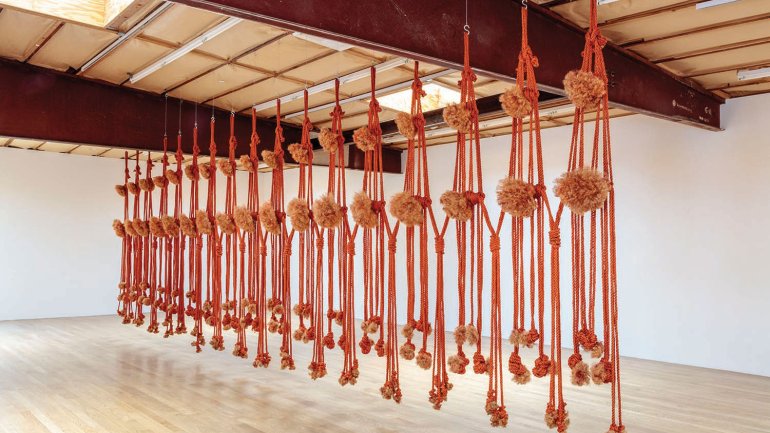Masters: Francoise Grossen
Masters: Francoise Grossen
Three discoveries have been pivotal in Françoise Grossen’s career as a fiber artist.
The first happened in 1964. The Swiss-born Grossen was a 21-year-old student of textile design at the School of Arts and Crafts in Basel when she saw a small show in Zurich featuring the work of Lenore Tawney, Claire Zeisler, and Sheila Hicks.
It was a revelation. “It really seduced me,” she recalls. The Americans’ work was so striking to her, so exciting, that she decided to pick up and move to the United States. “I had this image that it was happening here,” says the artist, who now lives in Manhattan, “and that’s when I started to really be in love with the whole field.”
Enthralled, she headed to UCLA to study with Bernard Kester. But there were barriers. “I was a poor student coming from Switzerland” – with no car and no material. Kester “arranged everything,” she says. “He took his car and took me to San Pedro to find some rope. And that was really an image of a professor that I didn’t have in Switzerland,” she says. That was her second discovery: An artist doesn’t have to do everything herself. Others can help.
An early work, Swan (1967), appeared in the landmark 1969 MoMA exhibition “Wall Hangings.” Then Grossen became one of the fiber revolutionaries of the 1970s and ’80s who broke with tapestry traditions, took fiber off the wall, and made it sculptural.
Which led to her third discovery: You never know when there will be a renaissance. Lately, Grossen’s work has been rediscovered. Curator Jenelle Porter included the groundbreaking Inchworm I (1971) in the 2014 traveling exhibition “Fiber: Sculpture 1960 to the Present.” Last year, Grossen had her first US retrospective at New York gallery Blum & Poe. And Five Rivers (1974) appeared in “Revolution in the Making: Abstract Sculpture by Women, 1947 – 2016,” which just closed at Hauser, Wirth & Schimmel in LA.
“All of this is a wonderful treat,” she says, “and has made life really beautiful.”
First job: Working for legendary textile designer Jack Lenor Larsen, whom she still admires for his unquenchable curiosity. “He’s always looking for new cultures, for new ways of approaching the material.”
New skills: Grossen exercised different muscles when she did enormous architectural commissions in the ’70s. “I had to present a model to convince a group of people that this is what they wanted for the building. And once they approved, I had to stick with the project, even if I had better ideas along the way,” she says. “This was a great discipline.”
Struggles: The ’80s and ’90s were a challenge. Her husband’s son died. Her husband died. The AIDS epidemic was peaking and seemed to hit fiber galleries especially hard; some closed. “Maybe I did a few less pieces,” she says, “but I learned a lot of other things.”
Her view of success: “For some, it’s to be on the cover of a magazine, and maybe it is for most people for a while,” she says. For her? Success is “being able to do what you really like.”
Read more about the 2016 American Craft Council Awards and winners.




